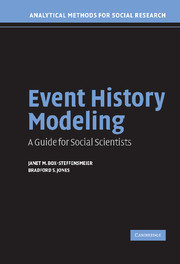Book contents
- Frontmatter
- Contents
- List of Figures
- List of Tables
- Preface
- 1 Event History and Social Science
- 2 The Logic of Event History Analysis
- 3 Parametric Models for Single-Spell Duration Data
- 4 The Cox Proportional Hazards Model
- 5 Models for Discrete Data
- 6 Issues in Model Selection
- 7 Inclusion of Time-Varying Covariates
- 8 Diagnostic Methods for the Event History Model
- 9 Some Modeling Strategies for Unobserved Heterogeneity
- 10 Models for Multiple Events
- 11 The Social Sciences and Event History
- Appendix: Software for Event History Analysis
- References
- Index
2 - The Logic of Event History Analysis
Published online by Cambridge University Press: 05 September 2012
- Frontmatter
- Contents
- List of Figures
- List of Tables
- Preface
- 1 Event History and Social Science
- 2 The Logic of Event History Analysis
- 3 Parametric Models for Single-Spell Duration Data
- 4 The Cox Proportional Hazards Model
- 5 Models for Discrete Data
- 6 Issues in Model Selection
- 7 Inclusion of Time-Varying Covariates
- 8 Diagnostic Methods for the Event History Model
- 9 Some Modeling Strategies for Unobserved Heterogeneity
- 10 Models for Multiple Events
- 11 The Social Sciences and Event History
- Appendix: Software for Event History Analysis
- References
- Index
Summary
The lexicon of event history analysis stems from its historical roots in biostatistics. Terms like “death,” “failure,” and “termination” are natural for analyses of medical survival data, but may seem awkward for social science analysis. In the context of medical research, survival data usually consist of longitudinal records indicating the duration of time individuals survive until death (if death is observed). In analyzing survival data, medical researchers are commonly interested in how long subjects survive before they die. The “event” is death, while the duration of time leading up to the death, the “history,” is the observed survival time. Analysts working with survival data may be interested in assessing the relationship between survival times and covariates of interest such as drug treatments.
Likewise, social scientists frequently work with “survival data,” although such data are generally not thought of in terms of survival and death. Nevertheless, much of the data social scientists use are generated from the same kinds of processes producing survival data. Concepts like “survival,” “risk,” and “failure” are directly analogous to concepts with which social scientists work. Thus, the concept of survival and the notion of survival and failure times are useful starting points to motivate event history analysis.
Event history data are, as Petersen (1995) notes, generated from failure-time processes. A failure-time process consists of units (individuals, governments, countries, dyads) observed at some natural starting point or time-of-origin.
- Type
- Chapter
- Information
- Event History ModelingA Guide for Social Scientists, pp. 7 - 20Publisher: Cambridge University PressPrint publication year: 2004

